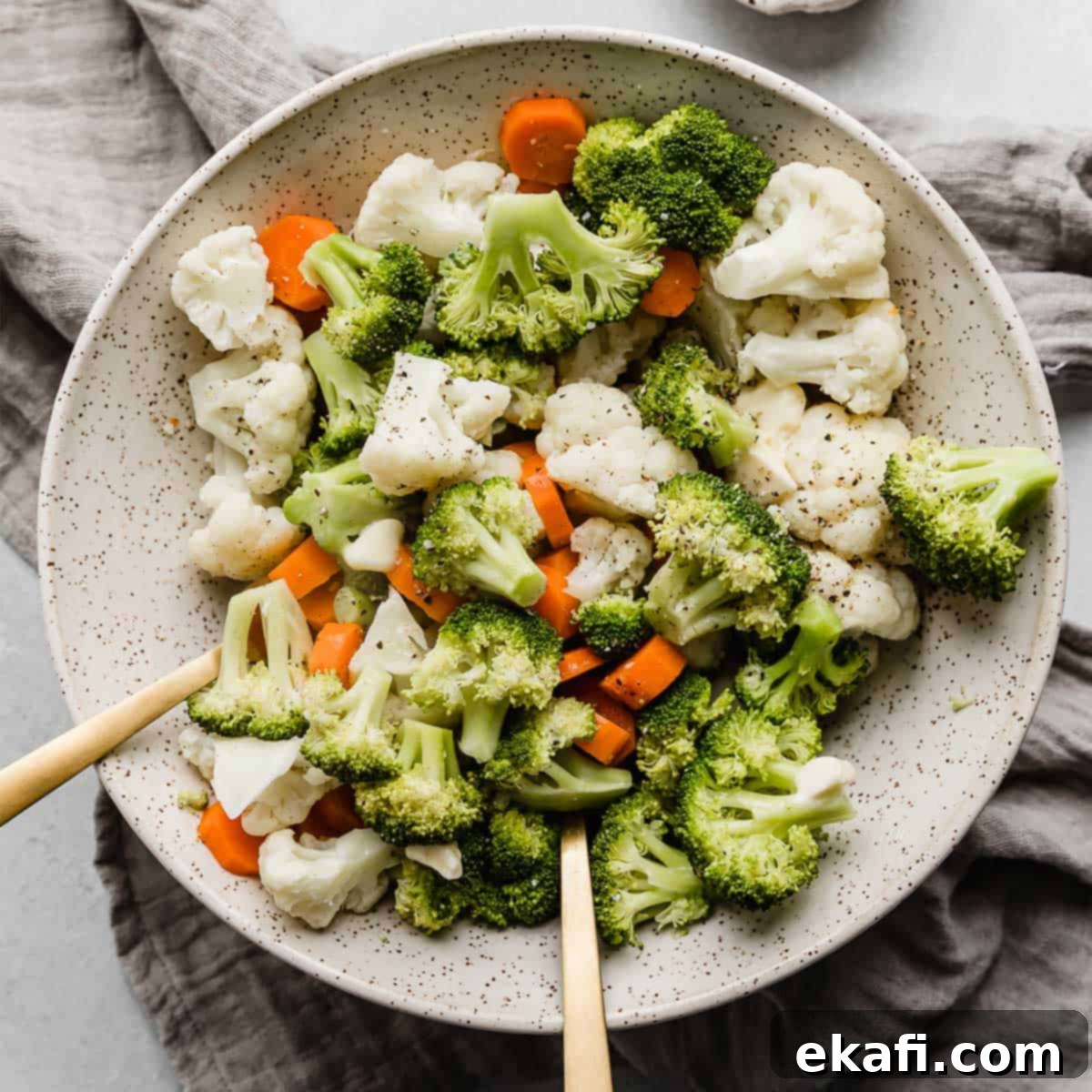Mastering Perfectly Steamed & Buttered Vegetables: A Simple, Healthy, and Customizable Side Dish
Buttered vegetables are a true culinary staple, offering a delightful blend of simplicity, nutrition, and incredible versatility. This easy side dish effortlessly complements a vast array of main courses, making it a go-to for busy weeknights and special occasions alike. Forget mushy, flavorless veggies; with just a few simple ingredients like your favorite vegetable combination, a touch of butter, salt, and pepper, we’ll guide you through the art of achieving perfectly steamed vegetables that are tender-crisp and bursting with natural flavor.
Imagine serving a vibrant medley of steamed and buttered broccoli, cauliflower, and carrots alongside your family’s favorite meals. This classic combination is not only visually appealing but also a fantastic way to boost nutrient intake. These delicious mixed vegetables are an ideal accompaniment to hearty dishes like our Creamy Dijon Mustard Chicken, the flaky goodness of Lemon Honey Glazed Salmon, the comforting flavors of Crock Pot Hawaiian Haystacks, or the rich and savory Mississippi Pot Roast. Once you master this simple steaming technique, you’ll find yourself reaching for this recipe again and again.
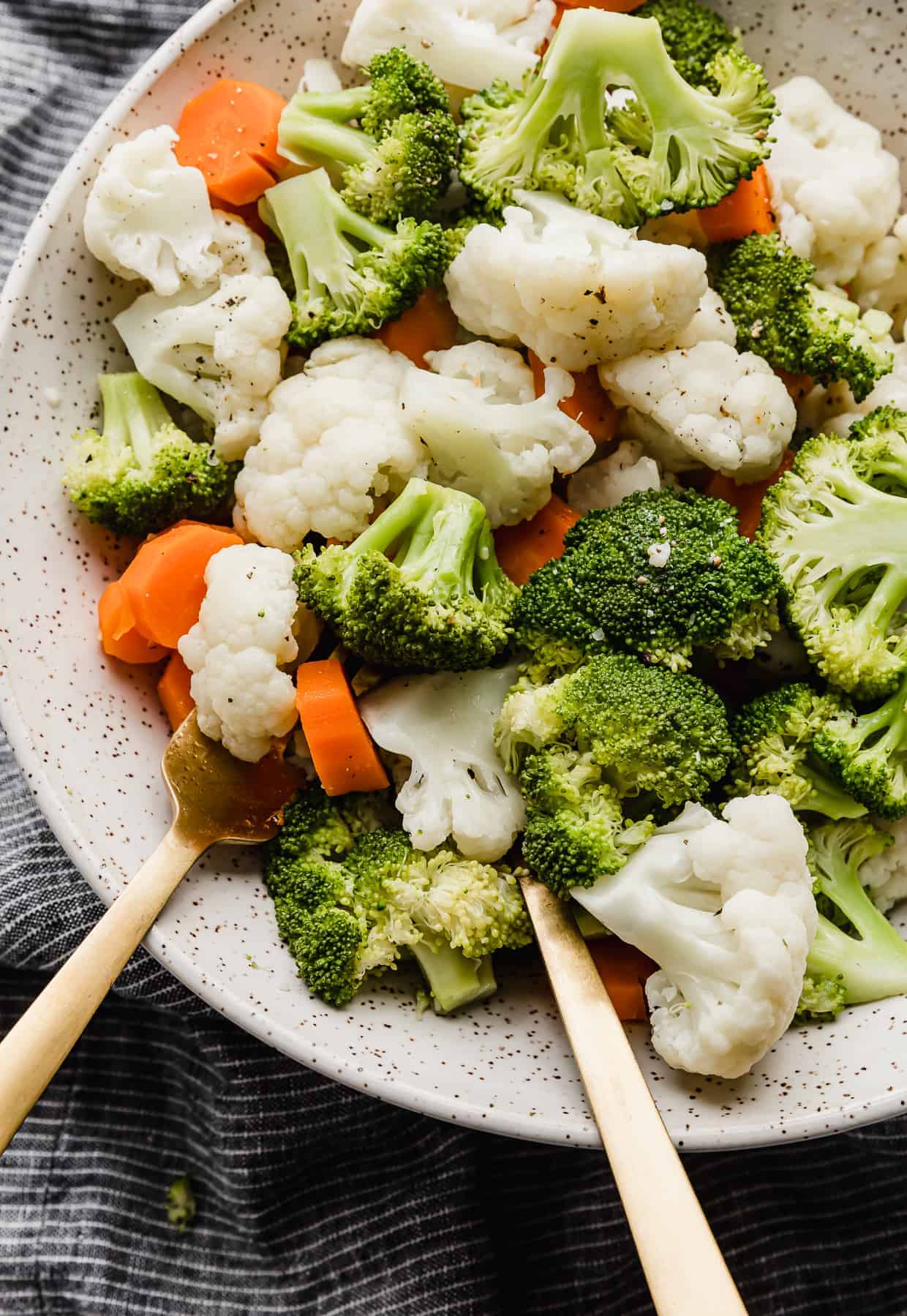
Why This Recipe for Buttered Vegetables Works Every Time
This recipe isn’t just another way to cook vegetables; it’s a reliable method designed for success. Here’s why it stands out:
- Effortless Perfection: This recipe provides an incredibly easy-to-follow guide, meticulously breaking down the proper method for steaming vegetables. By adhering to our carefully calibrated steaming times, you’ll achieve the perfect tender-crisp texture for carrots, broccoli, and cauliflower. Say goodbye to dreaded mushy vegetables and hello to perfectly cooked, vibrant produce. The simplicity means less stress in the kitchen and more time enjoying your meal.
- A Kid-Friendly Favorite (and Nutrient Powerhouse): Buttered vegetables are a fantastic side dish for any meal, and perhaps more importantly, an incredibly easy way to prepare vegetables that even your pickiest eaters will genuinely enjoy. The creamy richness of butter, combined with a touch of salt and pepper, enhances the natural sweetness and appeal of the vegetables, making them irresistible. Getting all the essential nutrients you and your family need at dinnertime has never been more delicious or straightforward!
- Ultimate Customization: This recipe is a culinary canvas waiting for your personal touch. Easily customize it by swapping out different vegetables for your favorites, or by adding various herbs and spices. Whether you prefer a single vegetable or a colorful medley, the core steaming technique remains the same, allowing for endless delicious variations. It’s a foundational skill that opens up a world of vegetable possibilities.
Essential Ingredients for Perfect Steamed & Buttered Vegetables
The beauty of this recipe lies in its simplicity and the quality of its fresh ingredients. Here’s what you’ll need, along with some tips for selection and preparation:
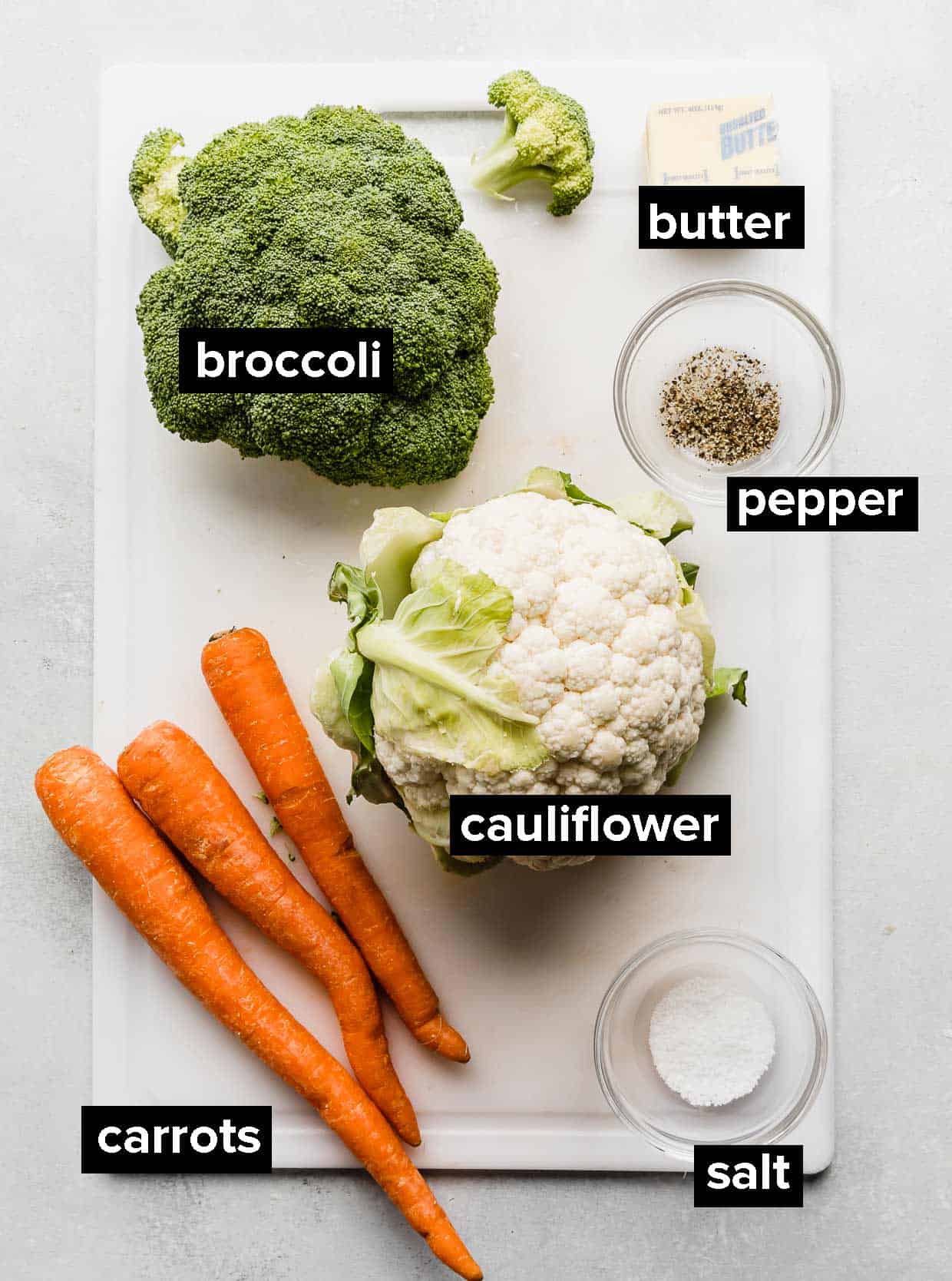
- Carrots: Start with fresh, firm carrots. Wash, peel, and cut them into even rounds, approximately 1/4 inch thick. This ensures they cook uniformly. Alternatively, you can use small baby carrots for convenience, but be aware their cook time will be slightly longer due to their varying size and density. Carrots add a lovely sweetness and vibrant color to the medley.
- Broccoli: Select bright green broccoli with firm stalks. Wash thoroughly and cut into smaller, equal-sized florets. Aim for pieces that are roughly the same size as your cauliflower florets for consistent cooking. Broccoli is a powerhouse of vitamins and minerals.
- Cauliflower: Choose creamy white cauliflower heads, free from brown spots. Wash and cut into florets that match the size of your broccoli pieces. Cauliflower offers a milder, slightly nutty flavor that complements the other vegetables beautifully.
- Salt & Pepper: These humble seasonings are crucial for enhancing the natural flavors of the vegetables. The amounts will depend entirely on your personal preference. We recommend using kosher salt for a clean taste and freshly cracked black pepper for its aromatic zing. Always season to taste!
- Butter: This is where the “buttered” magic happens! Use good quality butter, whether salted or unsalted (adjust added salt accordingly). Add the butter to the hot, freshly steamed vegetables; the residual heat will quickly melt it, allowing it to coat and distribute evenly throughout, creating that irresistible rich and glossy finish.
Step-by-Step Instructions: Achieving Perfectly Steamed Vegetables
Follow these simple steps to ensure your buttered vegetables are cooked to perfection – tender-crisp, vibrant, and incredibly flavorful.
- Prepare Your Vegetables: Begin by thoroughly washing all your vegetables. Peel the carrots and then slice them into uniform rounds, about 1/4 inch thick. For the broccoli and cauliflower, cut them into small, equal-sized florets. Consistency in size is key for even cooking. This preparation step is crucial for achieving the ideal texture across all vegetables.
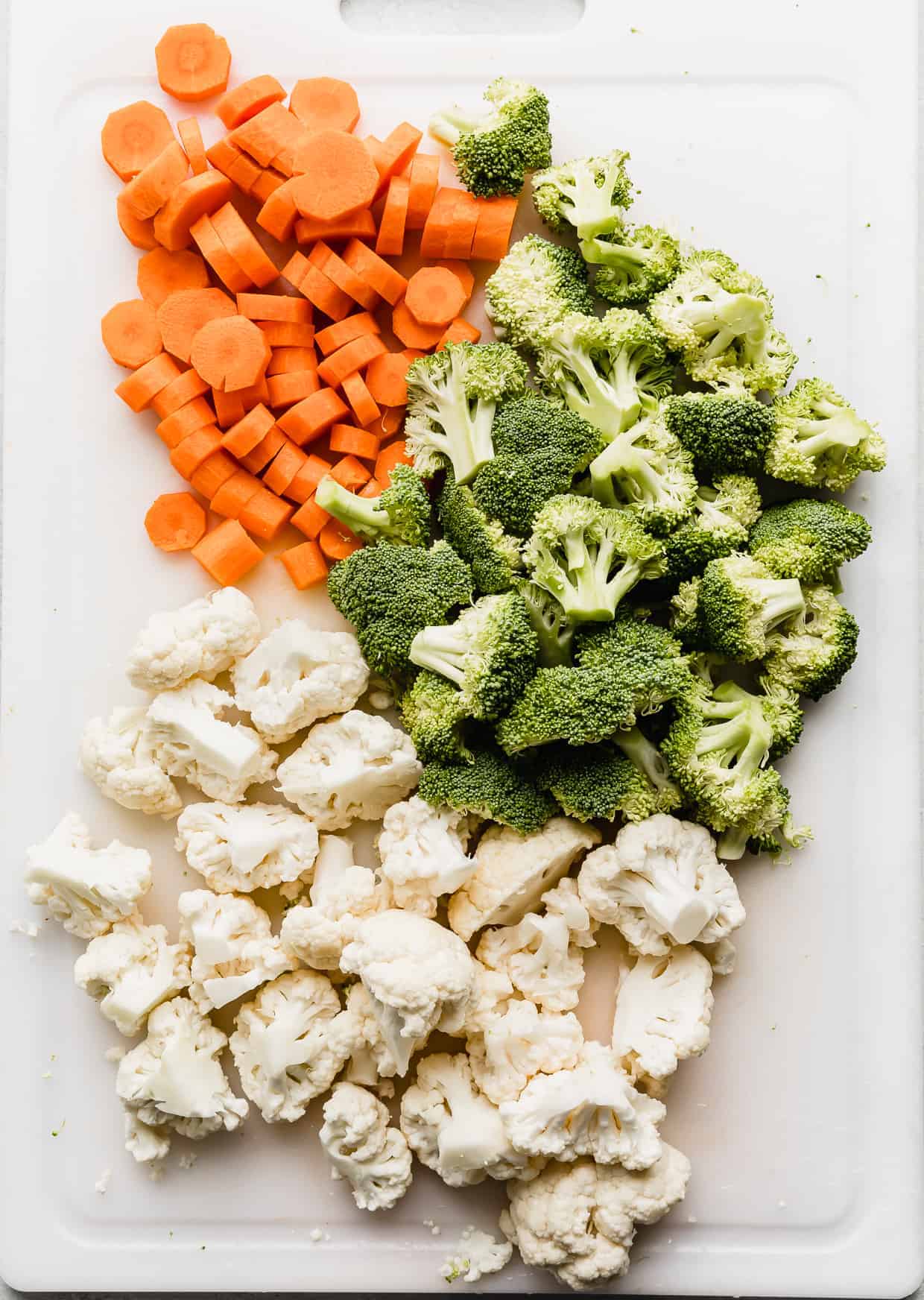
- Start Steaming the Carrots: Add approximately 1 to 1.5 inches of water to a medium-sized pot. If you have a steamer basket, place it into the pot, ensuring the water level is below the bottom of the basket. Add only the sliced carrots to the steamer basket (or directly into the water if not using a basket, being careful not to submerge them completely). Cover the pot with a tight-fitting lid and steam for 2-3 minutes. Carrots are denser and take longer to cook than broccoli and cauliflower, so we give them a head start.
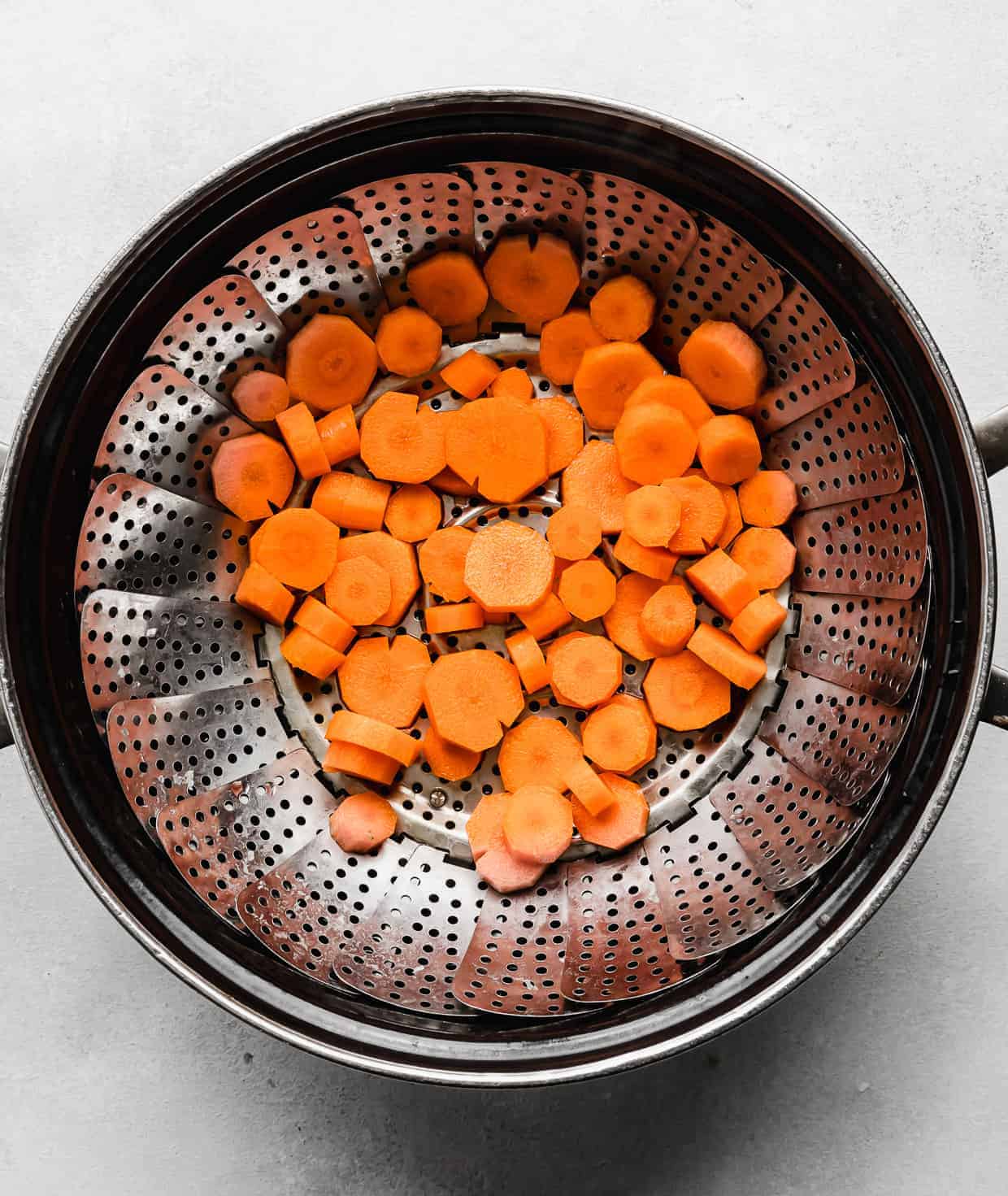
- Add Remaining Vegetables and Finish Steaming: After the initial 2-3 minutes, remove the lid and add the broccoli and cauliflower florets to the pot with the carrots. Recover the pot and continue to steam for another 6-8 minutes, or until all vegetables are fork tender but still retain a slight crispness. The key here is to avoid overcooking; we want them firm enough to hold their shape and offer a satisfying bite, not mushy. Periodically test with a fork to gauge doneness. The vibrant colors should remain bright.
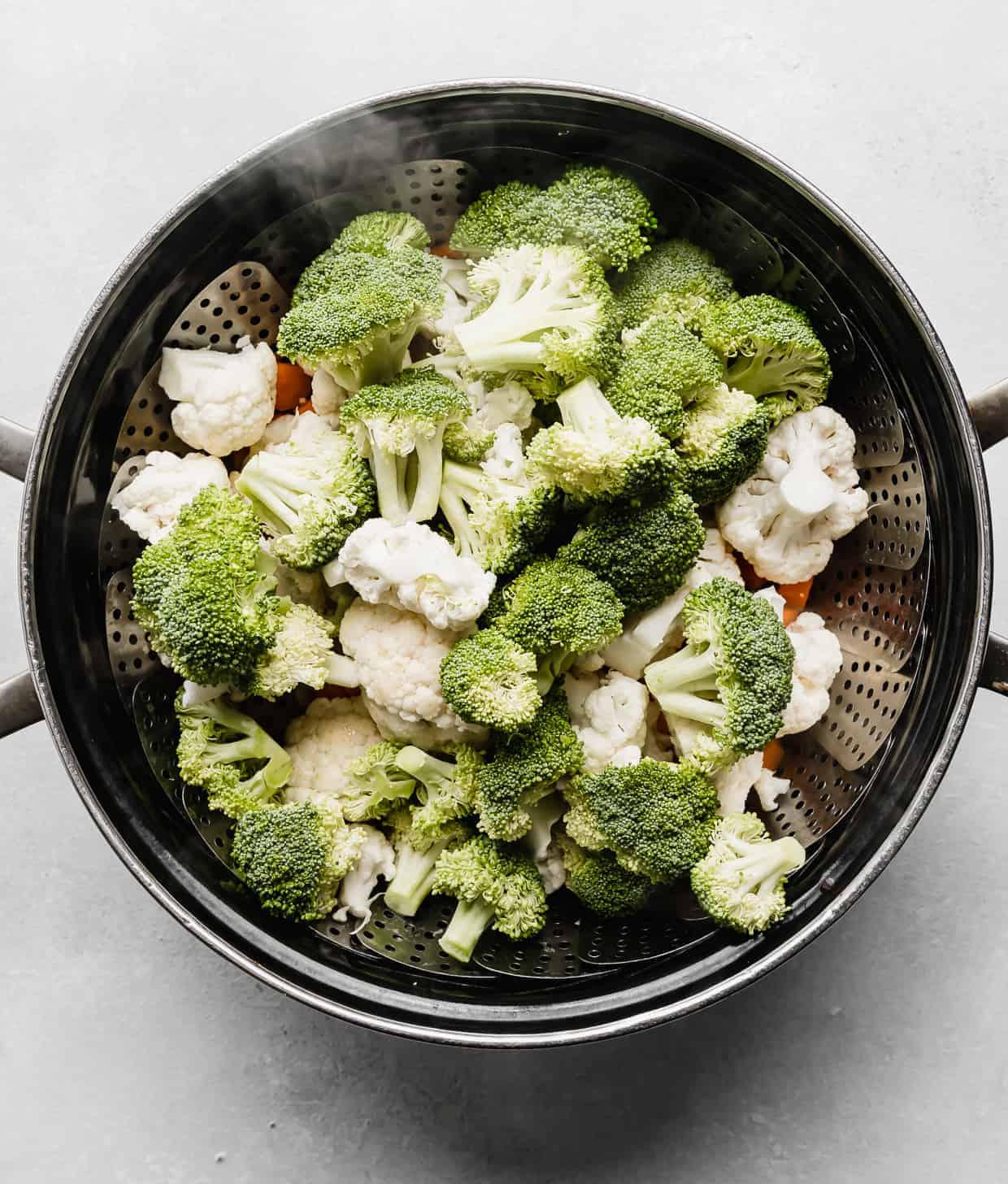
- Drain the Water: Carefully remove the steamer basket (if used) or simply drain all the water from the pot once the vegetables are cooked. You want to remove as much excess water as possible to prevent sogginess and allow the butter to adhere better.
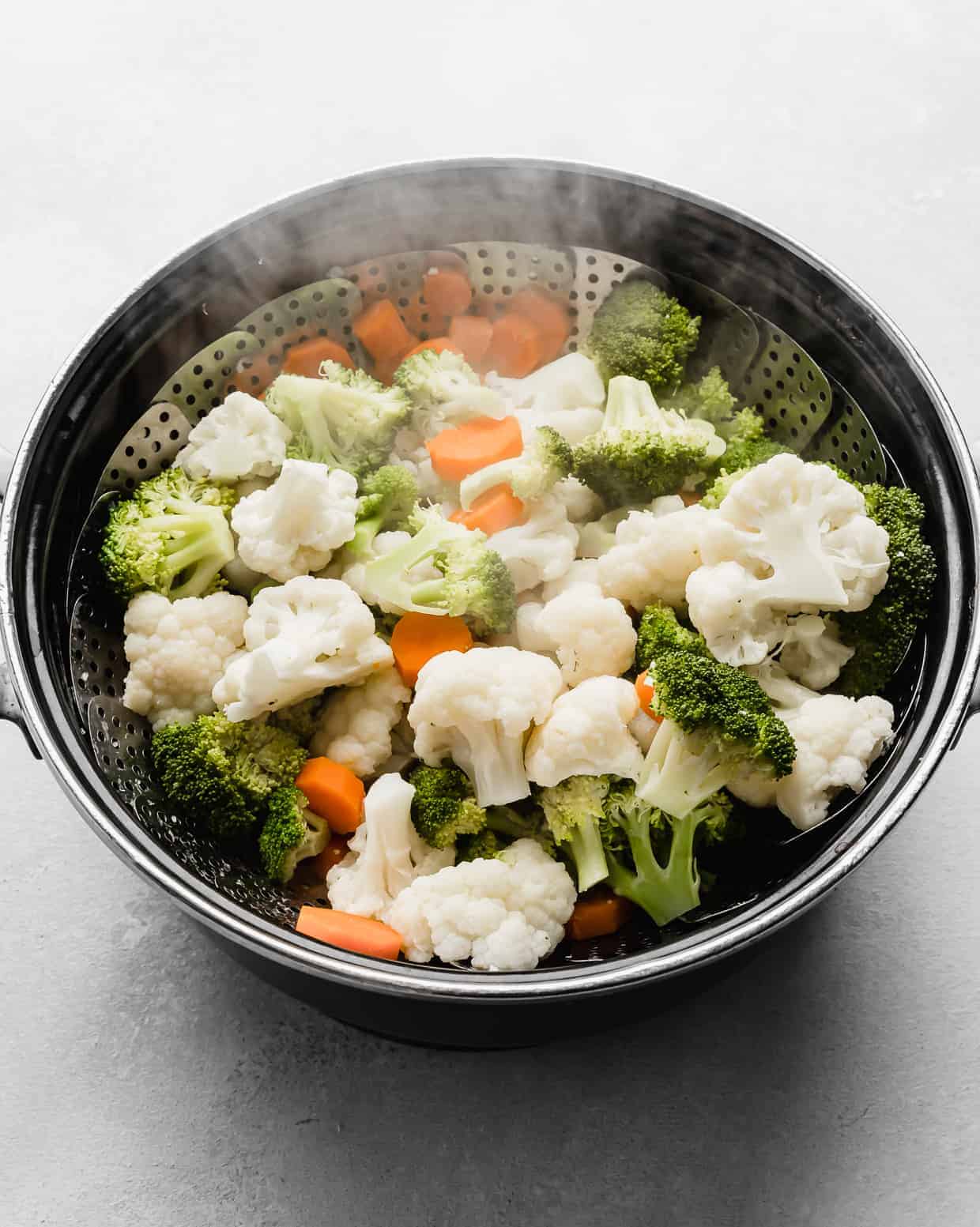
- Butter and Combine: Transfer the hot, drained vegetables to a serving bowl. Add the cubed butter over the top. The residual heat from the freshly steamed vegetables will melt the butter quickly. Stir gently to ensure all the vegetables are beautifully coated in the rich, melted butter.
- Season and Serve: Finally, season the buttered vegetables generously with salt and freshly cracked black pepper according to your preference. Give them one last gentle stir and serve immediately. They are best enjoyed warm, when the butter is still glistening and the flavors are at their peak.
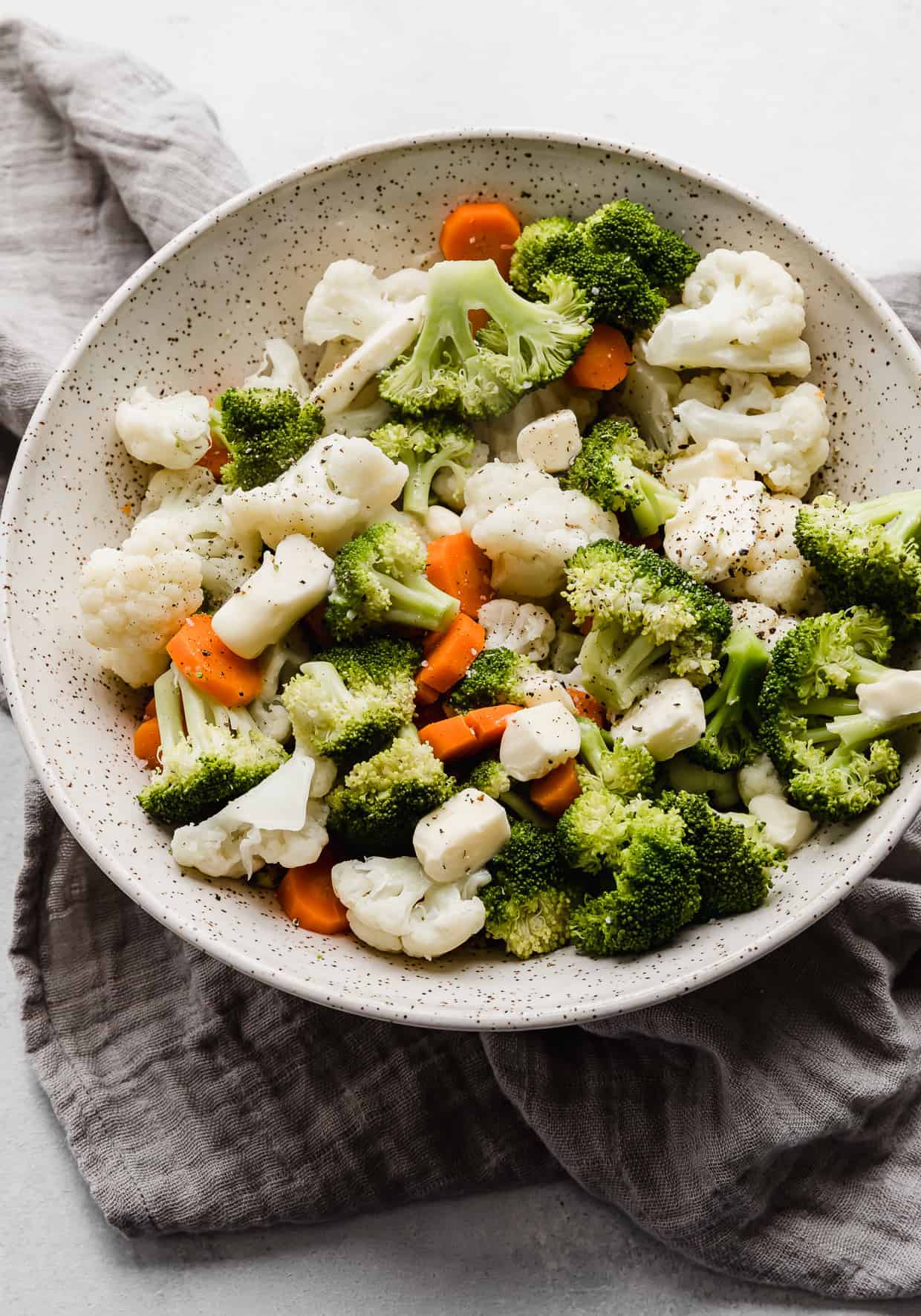
Recipe Tips & Flavorful Variations for Your Buttered Vegetables
While the classic buttered broccoli, cauliflower, and carrots are undeniably delicious, this recipe serves as a versatile foundation for countless other vegetable combinations and flavor enhancements. Don’t be afraid to experiment and truly make this dish your own!
Exploring Different Vegetable Combinations:
Feel free to mix things up by incorporating other fantastic vegetables into your steaming routine. Remember that cooking times might vary slightly based on density and size, so always aim for that “fork tender yet slightly crisp” sweet spot. Here are some excellent additions:
- Asparagus: Snap off the woody ends, steam for 3-5 minutes until bright green and tender-crisp.
- Brussels Sprouts: Trim the ends and halve larger sprouts. Steam for 5-8 minutes.
- Cabbage: Cut into wedges or thick shreds. Steam for 4-7 minutes until tender.
- Parsnips: Peel and cut into rounds or sticks, similar to carrots. Steam for 5-7 minutes.
- Corn (off the cob): Fresh or frozen kernels can be steamed for 3-4 minutes. For specific guidance, see our sweet boiled corn recipe.
- Edamame: Fresh or frozen shelled edamame beans are delightful. Steam for 3-5 minutes.
- Green Beans: Trim the ends. Steam for 4-6 minutes until vibrant and tender-crisp.
- Peas (green peas, snow peas, sugar snap peas): These delicate peas cook very quickly. Add them in the last 2-3 minutes of steaming. For more details on cooking frozen peas, check out our how to cook frozen peas recipe.
- Zucchini or Yellow Squash: Slice into rounds or half-moons. Steam for 3-5 minutes. Be careful not to overcook, as they can become watery.
- Green Bell Peppers: Cut into strips or chunks. Steam for 3-5 minutes for a slightly softened, still crisp texture.
Elevate Your Flavors Beyond Butter:
While butter, salt, and pepper are a perfect trio, you can easily enhance the flavor profile of your steamed vegetables with a few extra ingredients:
- Fresh Herbs: Stir in finely chopped fresh parsley, chives, dill, or thyme with the butter. Their aromatic notes will add a fresh dimension.
- Garlic: Mince a clove or two of fresh garlic and toss it with the hot buttered vegetables. The heat will gently cook the garlic, releasing its sweet aroma. Alternatively, use garlic powder.
- Lemon Zest or Juice: A squeeze of fresh lemon juice or a sprinkle of lemon zest brightens the flavors and adds a zesty tang that pairs wonderfully with most vegetables.
- Parmesan Cheese: For a cheesy twist, sprinkle freshly grated Parmesan cheese over the hot buttered vegetables before serving.
- Nutritional Yeast: A great option for a cheesy, umami flavor without dairy, perfect for a vegan or dairy-free alternative (see below).
- Spices: A pinch of paprika, a dash of onion powder, or even a tiny amount of red pepper flakes can add an interesting kick.
Storage and Reheating:
Cooked buttered vegetables are excellent for meal prepping. Store any leftover vegetables in an airtight container in the fridge for 3-4 days. To reheat, you can gently warm them in a microwave, on the stovetop with a splash of water, or in a preheated oven until just warm. Be careful not to overcook them during reheating to maintain texture.
Common Pitfalls to Avoid:
- Overcooking: The most common mistake! Overcooked vegetables become mushy, dull in color, and lose much of their nutritional value and natural flavor. Always aim for fork-tender with a slight bite.
- Uneven Cutting: If your vegetable pieces are not uniformly sized, some will be overcooked while others remain raw. Take an extra minute to cut everything consistently.
- Too Much Water: Using too much water for steaming can lead to vegetables boiling rather than steaming, and can dilute flavors. Stick to 1-1.5 inches at the bottom of the pot.
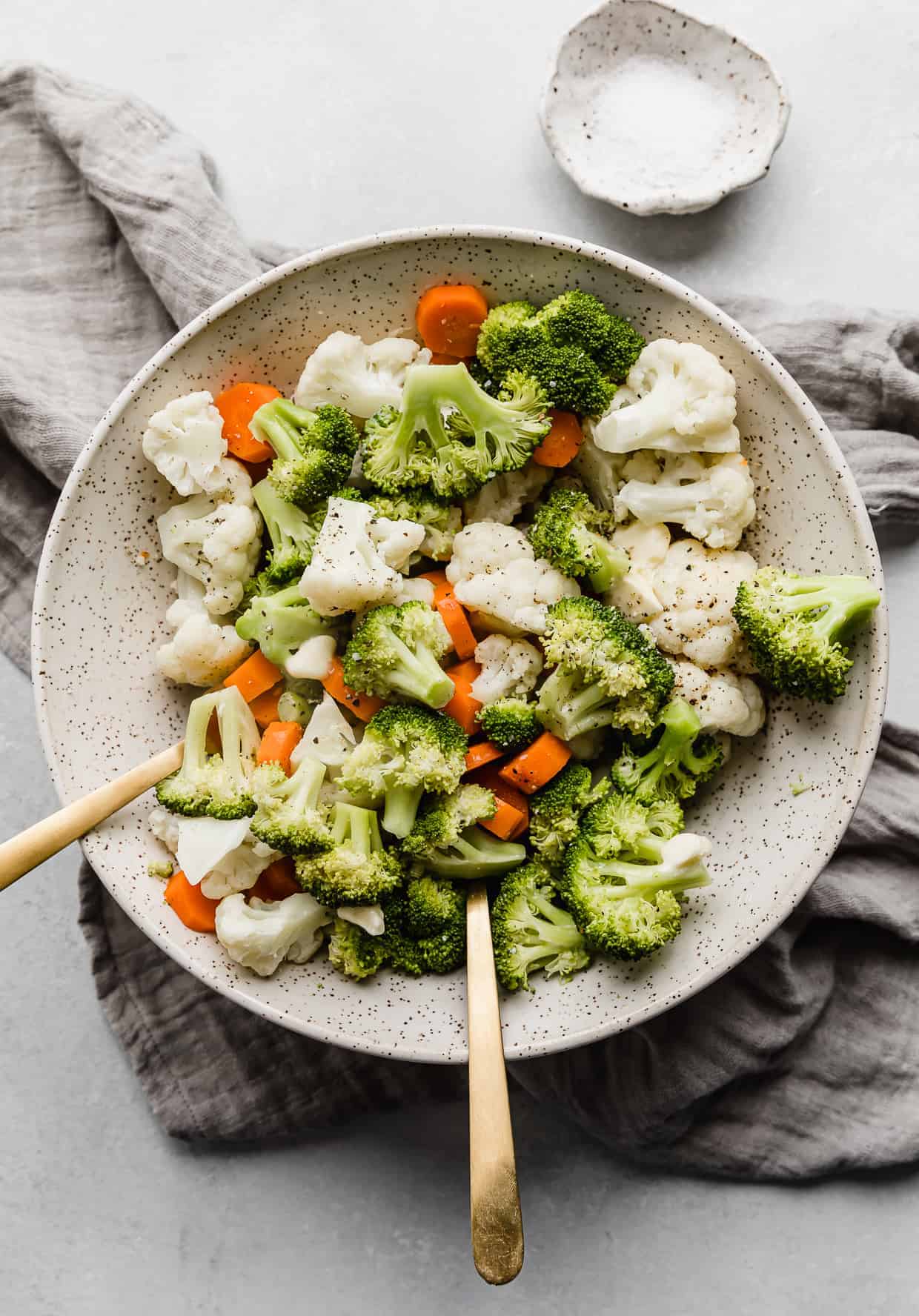
Frequently Asked Questions About Buttered Vegetables
Steaming vegetables with butter is a two-step process to ensure perfect texture and flavor. First, you steam the vegetables until they are fork-tender but still slightly crisp. This can be done using a steamer basket placed inside a pot with about 1 to 1.5 inches of water at the bottom, or directly in the pot without a basket (just ensure the vegetables aren’t submerged). Once the vegetables are steamed and drained of excess water, you transfer them to a serving bowl. Then, you add cubes of butter to the hot vegetables and stir. The residual heat will quickly melt the butter, coating the vegetables beautifully. Finally, season with salt and pepper to taste.
If you’re looking for an alternative to butter, there are several delicious options. A drizzle of high-quality olive oil or avocado oil is a fantastic choice, adding a healthy fat and a pleasant flavor. Simply toss the hot, steamed vegetables with your preferred oil, then season with salt and pepper. For a creamy, dairy-free option, you could try a plant-based butter alternative or a spoonful of cashew cream. To add a cheesy flavor without dairy, sprinkle on some nutritional yeast after steaming.
Making vegetables taste better often comes down to proper cooking technique and strategic seasoning. First and foremost, avoid overcooking your vegetables. Overcooked vegetables become mushy, lose their vibrant color, and much of their natural flavor gets cooked out (you’ll often notice this when the drained water is strongly colored). Cook them just until they are fork-tender but still offer a slight resistance. Their colors should remain bright and fresh. Once perfectly cooked, the addition of butter, a good quality salt, and freshly cracked pepper works wonders to bring out their natural sweetness and savory notes. Don’t forget to experiment with fresh herbs like parsley or dill, a squeeze of lemon juice, or a sprinkle of garlic powder for an extra flavor boost.
Steaming is one of the healthiest ways to cook vegetables because it helps to retain a higher percentage of their vitamins, minerals, and antioxidants compared to boiling or even roasting at high temperatures. Boiling can cause water-soluble vitamins (like Vitamin C and B vitamins) to leach into the cooking water. Steaming keeps the vegetables crisp and vibrant, making them more appealing, and the gentle cooking process preserves their natural flavor and texture, leading to a more nutritious and enjoyable eating experience.
Absolutely! This recipe works wonderfully with frozen mixed vegetables or individual frozen varieties like broccoli florets, cauliflower florets, or sliced carrots. You typically don’t need to thaw frozen vegetables before steaming; simply add them to the steamer basket (or pot) and increase the steaming time by a few minutes compared to fresh vegetables. They usually cook a bit faster than fresh because they are often blanched before freezing. Adjust cooking time until they reach your desired fork-tender consistency.
More Delicious Vegetable Recipes to Try
If you’ve enjoyed mastering these perfectly buttered vegetables, you’re sure to love these other fantastic vegetable dishes that make healthy eating both easy and incredibly tasty:
- Brown Sugar Roasted Carrots: A sweet and savory twist on classic carrots.
- Baked Zucchini Fries: A healthier, crunchy alternative to traditional fries.
- Roasted Brussels Sprouts: Crispy, savory, and unbelievably flavorful, especially with bacon.
- Baked Sweet Potatoes: A simple, comforting, and highly nutritious side or light meal.
Did you make this recipe? I’d love to hear about it! Click here to leave a rating and review, or scroll below the recipe card and do so there.
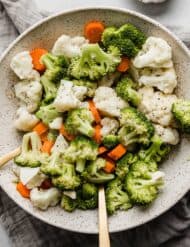
Print
SaveSaved!
Review
Buttered Vegetables
Ingredients
- water
- 3 large carrots – washed, peeled, and cut into disks, about 1/4″ inch thick
- 3 cups broccoli – washed and cut into equal-sized florets
- 3 cups cauliflower – washed and cut into equal-sized florets
- 5 tablespoons butter – cut into cubes (allows butter to melt faster)
- kosher salt – to taste
- freshly cracked pepper – to taste
Instructions
-
In a medium pot, add enough water to fill about 1-1.5″ inches up the sides. Place a steamer basket in the pot (see notes for steaming without a basket). Add the prepared carrots, cover tightly, and steam for 2-3 minutes. This gives the denser carrots a head start. Remove the lid and add the broccoli and cauliflower florets to the pot. Re-cover and continue to cook until all vegetables are fork-tender but slightly crisp, approximately 6-8 minutes more. Periodically test the vegetables with a fork to determine your desired level of doneness, ensuring they don’t become mushy.
-
Carefully drain all the water from the pot. Transfer the hot, steamed vegetables to a serving bowl. Add the cubed butter over the top and stir gently to combine. The butter should melt quickly and evenly coat the steaming hot vegetables, creating a rich and glossy finish.
-
Season the buttered vegetables generously with kosher salt and freshly cracked pepper to taste. Give them a final stir and enjoy warm as a delicious and healthy side dish.
Notes
Testing for doneness: After adding the broccoli and cauliflower, I typically steam the vegetables for about 8 minutes. This time can vary depending on multiple factors: 1) how large your florets and carrot slices are. 2) your desired doneness level (some prefer more crisp, some prefer softer). Always test with a fork!
Butter: Feel free to adjust the amount of butter you use to your liking. For a lighter touch, use less; for a richer flavor, add a bit more.
Variations: Mix things up with different combinations of vegetables and additional seasonings as mentioned in the “Recipe Tips” section above. Some great options include:
- Asparagus
- Brussels Sprouts
- Cabbage
- Parsnips
- Corn (off the cob) — or see my sweet boiled corn recipe
- Edamame
- Green Beans
- Peas (green peas, snow peas, sugar snap peas) — or see my how to cook frozen peas recipe
Storing: Store leftover buttered vegetables in an airtight container in the fridge for 3-4 days. Reheat gently in the microwave or on the stovetop.
Nutrition
